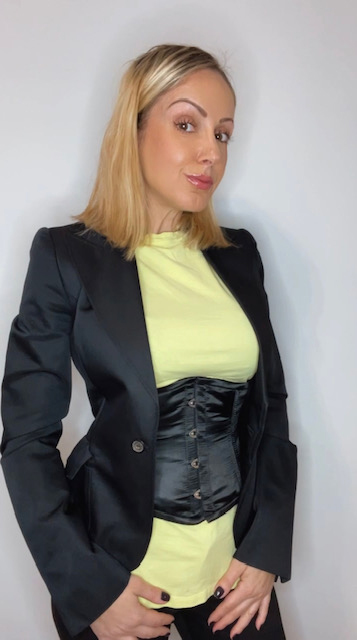Blog
Fun with Fan Lacing: The Why & How of This Intricate Corset Lacing Style
Fan lacing, so called because laces are fanned out to create a series of nested vees, is a very fancy way of actually simplifying the process of tightening your corset.
As long-time corset wearers already know, tightening laces on your own can be awkward, to say the least. If you don’t want to risk a hernia straining to lace yourself in, you’ll be happy learn that there are some tricks you can try.
A doorknob can help in a pinch – just loop a rabbit ear over either side and walk forward until your waist is cinched.
That said, you will need to make adjustments as you go to ensure uniform tightening, and some people simply aren’t flexible enough to reach back and tug at their own laces. This is where fan lacing can truly lend a hand.
Fan lacing is more than just eye-catching, it’s a functional means of getting your curvature in order when you lack the dexterity to cinch lacing on your own.
What is fan lacing and how does it work? Here’s the skinny on this simple slimming technique.
What is Fan Lacing?
The first thing you need to know is that fan lacing, also referred to as “cluster”, “camp”, or “cross” lacing, isn’t your average corset lacing.
It requires some special equipment and know-how. Essentially, each facing pair of grommets is going to get its own lace, so if you have an 8-hole corset (i.e. sixteen holes paired to make two rows of eight), you’ll have eight laces.
Although some manufacturers may get real fancy with their lacing, the typical fan lacing pattern is accomplished by running a lace in a straight line between facing grommets and pushing the ends through grommets from the inside.
The ends are then crossed over each other and pulled in opposite directions toward metal slides located on either side of the garment, typically at the waistline.
This is repeated for each set of grommets all the way down, with the trailing ends of laces being secured to grommet-like holes in the slides. The slides also feature a slot on the other side, into which a ribbon or belt can be fed.
Belts are attached to the front side of the corset, and once trailing ends are woven through the slots on slides, the ends can be pulled tight in front – like backpack straps – to tighten fan lacing, pulley style. The slot is designed to hold belt ends securely in place.
Some corsets with a lot of grommets may feature more than one slide on each side to better distribute tension and provide added opportunity for custom tightening. Some feature decorative fan lacing, more for fun than function, so make sure you know what you’re getting.

Pros and Cons of Fan Lacing
The main draw of fan lacing is the ease it adds when you have to tighten laces without the aid of your lady’s maid.
Sigh, if only we still had ladies’ maids to dress us and provide the upstairs/downstairs scuttlebutt on eligible bachelors. Guess we’ll have to make do with fan lacing and Tinder profiles.
The only potential drawback to fan lacing is if laces snap. With robust lacing, this shouldn’t be a frequent occurrence, but depending on the lacing pattern used, you could end up with a confusing re-lacing situation. You might want to ask your manufacturer to provide a lacing pattern when you purchase your corset, just in case.
Stay up-to-date with weekly blog posts, waist training tips, and the chance to win one of our monthly corset giveaways, like us on Facebook & subscribe to our mailing list today! Want to find the perfect steel boned corset? Shop some of our favorites: underbust corsets, overbust corsets, corset dresses. You can also shop our corsets by material: cotton corsets, denim corsets, leather corsets, mesh corsets, pvc corsets, and satin corsets.

My name is Rachel, I am the owner of Glamorous Corset, a small business founded by me in 2010. Back In 2005, I was in a car accident that left me with a herniated disk. Much to my surprise I learned steel boned corsets were beneficial to several medical injuries including mine. I was always intrigued with corsetry, their history and their beautiful aesthetic. I love sharing knowledge about corsets, educating my wonderful readers and breaking the negative stigma related to corsetry. In combination with my years of research and personal experience I hope my articles are useful and can help anyone who has struggled with some of the same things I have. More about me…


